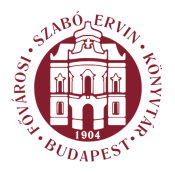Szegő Dóra - Szegő György: Synagogues - Our Budapest (Budapest, 2004)
The Lajos utca Synagogue
his famous sermons under the title Ro& mor decor in Venice. The best known Buda rabbi of the period was Efraim ha-Kohen, who was consulted on religious disputes from all over Europe. He was followed by Jacob Ashkenazi, who came under the influence of the pseudo-Messiah Shabbetai Tzvi. The fate of the congregation of Táncsics utca (Jewish street) was sealed in 1686. Following a failed siege, Alexander (Sender) Tauszk agreed with Charles of Loraine that the Jews were to be spared for a ransom. And yet the Temple was destroyed by the liberators after the siege of Buda in 1686. The reason cited was that the Jews who had coexisted with the Turks, had collaborated with them when the city was recaptured (alternative sources reported that they had been forced into auxiliary service by the cannons). When the city walls fell, many Jews took refuge in the great synagogue. They were briefly defended here by Charles of Lorain's bodyguards. However, looting soldiers from Brandenburg broke into the building and, having massacred many of the refugees, set fire to the Temple. They burnt most of the Torah scrolls, too. The remains of the dead unearthed during the excavations of the 1960s were reburied, after nearly three hundred years, by the Hevrah Kaddishah (the Holy Society of Funeral Rites) according to Jewish rites in the Kozma utca cemetery, where the society raised a stele to honour their memory. Some five hundred of the thousand-strong community of Buda’s Jews escaped. Three hundred wealthy Jews, 35 Torah scrolls, and Sender Tauszk himself were held in captivity in Nikolsburg for 270 days until Europe's Jewry raised another ransom. Survivors came to call themselves Ofner, meaning 'of Buda’. One of them, Izsák (Yitzhak) Schulhof, gave a moving account of how his children, wife, friends and neighbours had been slaughtered. After the Jewish population was carried off to captivity, a new community of Jews protected by a royal charter once again settled down on the Castle Hill, but as they were still banned from inside the Castle walls, they took up their new residence in the Víziváros. In the 1700s they suffered various injustices at the hands of the burghers and the city council—their prayer- room was demolished, and in 1746 they were driven out of the Víziváros. Many of them moved to Óbuda. It was only after Joseph II issued his decree granting freedom of worship in 1781 that the Jewish community of Buda was reborn. The Lajos utca Synagogue There were Jews living in mediaeval Óbuda until the Battle of Mohács. Although they were not permitted by law to settle in royal free boroughs, they could settle on the estates of landowners. Settlement, however, involved obliga16
